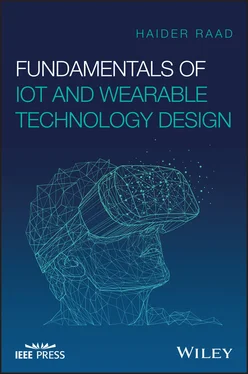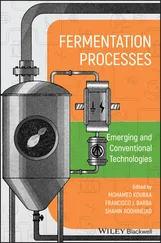It is also worth noting that not all wearable devices require connectivity, for example, a simple pedometer and an ultraviolet monitor could operate offline. Other wearables require minimal connectivity only.
Although IoT and wearable devices have a lot in common in terms of design aspects, components, and technologies and protocols used, there are still some real differences that architects and designers need to be aware of. Figure 1.4shows a table summarizing the main differences between M2M, IoT, and Wearable Technology.

Figure 1.4 A summary of the main differences between M2M, IoT, and Wearable Technology.
1.1.3 IoT: Historical Background
The term “IoT” has not been around for so long. However, the idea of machines communicating with one another has been brewing since the telegraph was developed in early 1800s.
The first wireless transmission over a radio took place in 1900, bringing about endless innovations. This crucial ingredient of the future IoT was complemented by the inception of computers in the 1950s.
An essential component of the IoT is the Internet itself which was initiated as part of the Defense Advanced Research Projects Agency (DARPA) in 1962 and then progressed into ARPANET in 1969. In the 1980s service providers started promoting the commercial use of ARPANET, which matured into today's Internet.
The term IoT was not officially coined until 1999 when Kevin Ashton, the executive director of Auto‐ID Labs at MIT, was the first to describe the Internet of Things in a presentation for Procter & Gamble. During his speech, Ashton stated:
Today computers, and, therefore, the Internet, are almost wholly dependent on human beings for information. Nearly all of the roughly 50 petabytes of data available on the Internet were first captured and created by human beings by typing, pressing a record button, taking a digital picture or scanning a bar code. The problem is, people have limited time, attention, and accuracy. All of which means they are not very good at capturing data about things in the real world. If we had computers that knew everything there was to know about things, using data they gathered without any help from us, we would be able to track and count everything and greatly reduce waste, loss and cost. We would know when things needed replacing, repairing or recalling and whether they were fresh or past their best.
Kevin Ashton also pioneered the radio‐frequency identification (RFID) use in supply chain management and believed that it was essential for the deployment of the IoT. He concluded if all devices were uniquely identified, computers could then manage, track, and inventory them.
A foundational element in realizing the IoT concept was the creation of IPV6. Steve Leibson of Intel Corporation once stated: “The address space expansion means that we could assign an IPV6 address to every atom on the surface of the earth, and still have enough addresses left to do another 100+ earths.” In other words, we have enough IP addresses to uniquely identify all the objects in the world, for hundreds of years to come.
One of the early examples of an Internet of Things is from 1982, when four students from the School of Computer Science department installed switches in a Coca Cola machine at the Carnegie Melon University. The students would connect by ARPANET to the appliance and remotely check the availability of the drink, and if it was cold, before making the trip to the machine. This experiment had inspired numerous inventors around the world to devise their own connected appliances.
After the invention of the World Wide Web by the British scientist Tim Berners‐Lee in 1989 and the launching of commercial Global Positioning System, inventors had been able to develop interconnected devices way more efficiently. One of the first examples was an Internet‐connected toaster introduced by John Romkey in 1990, which is considered by many as the first “real” IoT device.
In 1991, two academicians who worked at the computer laboratory in the University of Cambridge set up a camera to provide live picture of a coffee pot (known as the Trojan Room coffee pot) to all desktop computers on the office network to save people working in the building time and from getting disappointed of finding the coffee pot empty after making the trip. This invention was a true inspiration for the world's first webcam. A few years later, the coffee pot was connected to the Internet and gained international fame until it was retired in 2001.
In the year 2000, LG announces Internet Digital DIOS, the world's first Internet‐enabled refrigerator. The refrigerator became a buzzword despite its commercial failure.
In 2004, Walmart Inc. required its top suppliers to assign RFID tags to cases and pallets in place of barcodes by 2005 to enhance their supply chain operations. The suppliers were unhappy with the new requirements as Electronic Product Code (EPC) tags were pricey and seemed unnecessary. Walmart, subsequently, offered the suppliers to disclose point of sales information which led to a decreased merchandise thefts and labor requirements. Currently, EPC is one of the international standards, connecting billions of “things” worldwide.
The year 2005 witnessed the first Internet‐connected robot, the Nabaztag rabbit. The bunny‐shaped robot is capable of gathering weather reports, news, and stock market updates through Wi‐Fi connectivity and reading them to the consumer. Despite its retirement in 2015 due to technological impediments, Nabaztag proved that IoT can be integrated into everyday lives.
The First International Conference on the Internet of Things took place in Zurich, Switzerland, in 2008. The event was the first conference of its kind with participants from 23 countries. The same year marked the first time where more “things” are connected to the Internet than people. A year later, Google started the first testing of self‐driving cars while St. Jude Medical officially became an adopter of IoT for healthcare.
The year 2010 marks the first time IoT was recognized on a governmental level where China's head of government Wen Jiabao decided to pay special attention to IoT as one of the remedies to his country's financial crisis and adopting it across top strategic industries. The same year also marks the first implementation of machine learning techniques in IoT devices. Nest smart thermostat was the first IoT product to adapt to the user's habit and thus optimizing the air conditioning schedule.
By the year 2013, IoT had evolved into a system that utilizes multiple technologies, ranging from embedded systems and wireless communication to electromechanical sensors and control systems.
In 2014, Google Inc. acquires Nest after spotting the potential behind IoT and smart home devices in particular. Moreover, Google's self‐driving car prototype was ready for testing on public roads but would not perform the official test drive until the following year.
On the 6th November of the same year, Amazon releases Echo, the first commercially successful voice‐controlled ambient device and IoT hub. It is also anticipated that Amazon 's device will be one of the most disruptive technologies in the next generation of enterprise IoT solutions.
The Global Standards Initiative on IoT takes place in 2015. The event's main objective was to establish a unified approach to the development of IoT technical standards and to support the adoption of the technology, globally.
In 2016, the automotive giant General Motors invests $500 million in Lyft aiming at developing a network of self‐driving cars. In the same year, Apple showcases HomeKit products at the Consumer Electronics show. HomeKit is a platform that allows developers to utilize a comprehensive list of software tools for smart home application. In the meantime Google releases Google Home, another smart ambient device competing with Amazon's Echo. This year also witnessed the emergence of the first IoT malware.
Читать дальше













